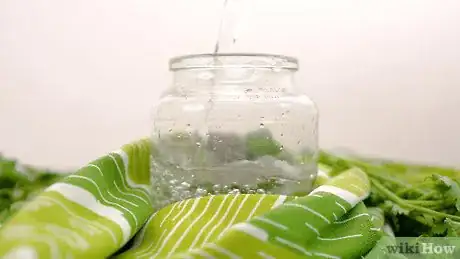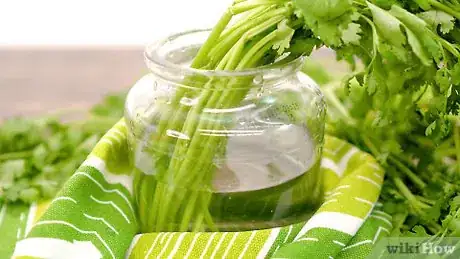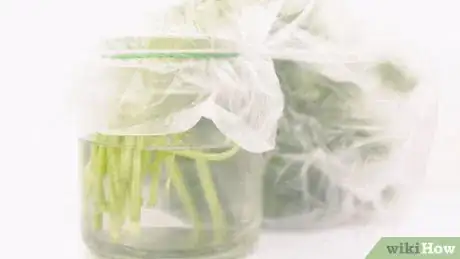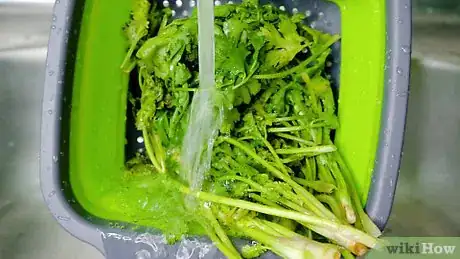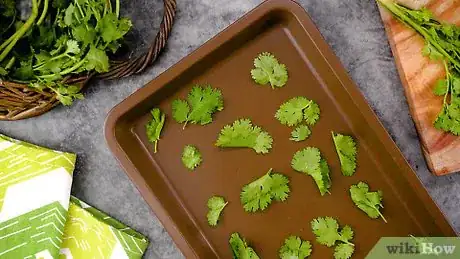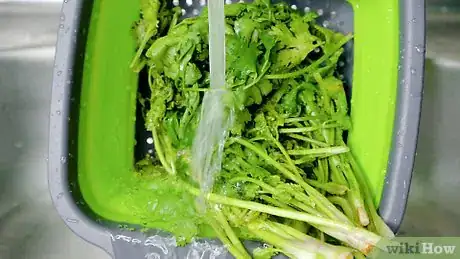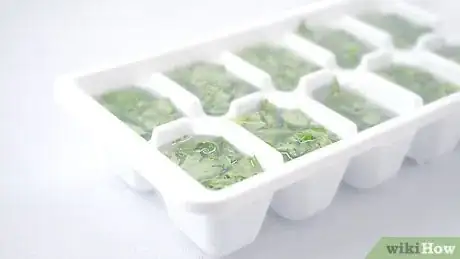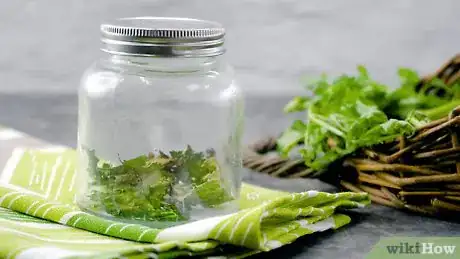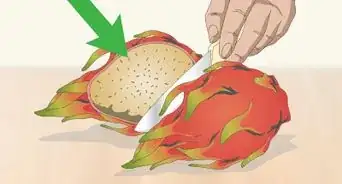This article was co-authored by Randall Chambers. Randall (Randy) Chambers is a Personal Chef and the Owner of Luxury Meals From Home based in Arvada, Colorado. He has more than 16 years of commercial kitchen experience, five years of sous chef experience, and two years of experience as an executive chef. Chef Randy draws inspiration from his half Bolivian background and his forte is South American cuisine. He holds an Associate’s degree in Culinary Arts from The Art Institute.
There are 8 references cited in this article, which can be found at the bottom of the page.
wikiHow marks an article as reader-approved once it receives enough positive feedback. In this case, several readers have written to tell us that this article was helpful to them, earning it our reader-approved status.
This article has been viewed 295,443 times.
Cilantro is a great herb to spice up your cooking. Unfortunately, it doesn't stay fresh for very long, so if you don't use a whole batch it could go to waste. Luckily there are a few tricks you can use to make your cilantro last for weeks or even months. With a glass of water and a plastic bag, you can keep fresh cilantro ready to use in your fridge for about two weeks. Keeping cilantro in your freezer can preserve it for several months. For even longer-term storage, dry the cilantro leaves and store them in your spice cabinet. Try one or more of these methods to ensure you always have cilantro ready to use.
Steps
Storing Fresh Cilantro in the Refrigerator
-
1Fill a cup or jar with 2–3 inches (5.1–7.6 cm) few inches of water. The cilantro doesn't have to be submerged in water. Only the ends of the stalks need to be in the water. 2–3 inches (5.1–7.6 cm) of water provides the cilantro with plenty of water to keep it fresh.[1]
- Rinse out the jar first to make sure there are no contaminants that could hurt the cilantro.
-
2Dry off the cilantro with a paper towel. The cilantro should be dry when placed in the refrigerator. Use a paper towel and gently pat it dry. Don't rub or you could tear the leaves.[2]
- Even if the cilantro looks dirty, don't wash it now. Store it and save the washing for right before you use it.
Advertisement -
3Cut the stems 1 inch (2.5 cm) from the bottom. Grab a bunch of cilantro and lay it flat on a cutting board. Using a sharp kitchen knife, cut away the bottom portion of the stem. This exposes the fresh part of the stem and lets it absorb water while it's stored. Make sure the knife is sharp so you don't tear off parts of the stem.[3]
- A sharp pair of kitchen scissors would work as well.
- Work quickly after cutting. The stem edge starts drying out immediately after cutting, so don't leave it out to dry.
- You may choose to keep the stems, since they are edible. They can be blended along with the leaves when making a salsa, for instance.
-
4Insert the cilantro into the water stem first. Right after cutting the ends off, put the cilantro into the cup. Make sure the leaves are facing up and the stems are covered by the water.[4]
- Place the herbs in gently. Don't force them into the jar. Just let them sit in the jar like flowers in a vase.
-
5Cover the cilantro loosely with a plastic bag. Place a clean plastic baggie loosely over the jar. Make sure the bag covers the cilantro leaves and the mouth of the jar. This keeps air from drying out the cilantro.[5]
- You could use a rubber band or strip of tape to keep the bag in place.
- Make sure the bag is loose. Don't push the leaves down.
- Another option is to put the cilantro in a plastic bag lined with paper towels to absorb the moisture and keep the cilantro fresh.
-
6Place the jar in the refrigerator. Cilantro thrives in cold weather, so the refrigerator is the perfect environment to keep it fresh. Put it somewhere out of the way where it won't be knocked over.
- Make sure you can see the cilantro when you place it in the refrigerator. That way you can monitor its freshness and know when it's dried out.
-
7Change the water when it starts to discolor. Your cilantro requires fresh water, so replace the water in the jar every few days. Take out the jar and gently lift out the cilantro. Then dump the water and rinse out the jar. Refill it with water and put the cilantro back in.[6]
-
8Use the cilantro within 2 weeks. By regularly changing the water and keeping the cilantro cold, it could last up to 2 weeks in the refrigerator. Continue monitoring its condition and dispose of it when it's no longer fresh.[7]
- When the cilantro's leaves darken and turn a dark green, it's going bad. Brown leaves indicate the cilantro is dead.
- Spoiled cilantro emits a pungent smell. If you discover an unpleasant smell, dispose of the cilantro.
Freezing Cilantro in Plastic Bags
-
1Wash the cilantro sprigs. Place your cilantro in a colander and hold it under the sink. Run the water while shaking the colander so the water reaches all of the cilantro. Then turn the water off and let the cilantro drip dry for a few minutes.[8]
-
2Pat the cilantro dry with a paper towel. Use a paper towel and gently pat the cilantro to pick up any excess water. Don't rub hard or you could tear the leaves.[9]
- Any easy trick for drying all the cilantro is wrapping the entire contents in a paper towel and gently rolling it. This catches all the excess water.
-
3Slice the leaves off the stalks if you prefer smaller portions. You can freeze whole stalks if you want, but then it would be harder to measure out when you want to use cilantro. Plan ahead by slicing the leaves off the cilantro stalk. Use a sharp knife or pair of kitchen scissors to avoid tearing the cilantro. Gently cut away the leaves and dispose of the stalks. This way, you can go into the freezer and take only a small amount when you need it.[10]
-
4Spread the cilantro out on a baking sheet. Place a layer of freezer paper down first so the leaves don't stick to the tray. Lay the cilantro out in a single layer on the baking sheet. Make sure the leaves don't touch teach other or they'll stick together.[11]
- Wax or parchment paper will also work if you don't have freezer paper.
- Use more than one sheet if you have a lot of cilantro. Don't pile it up on one sheet.
-
5Place the sheet in the freezer for 30 minutes. This freezes each cilantro leaf individually so they won't stick together later on.[12]
- Don't pile anything on top of the sheet and lay it flat so none of the leaves fall off.
-
6Transfer the frozen cilantro to plastic freezer bags. After 30 minutes, take the baking tray out of the freezer and immediately transfer the cilantro into a freezer bag. Don't let the cilantro start defrosting or it will all stick together when it refreezes.[13]
- Squeeze all the air out of the bag before sealing it.
- You can stay organized by marking each freezer bag with the name of the herb, the date you froze it, and how much the bag contains.
-
7Store the bag in the freezer for 1-2 months. Put the bag back in a safe place in the freezer. Your cilantro could last up to 2 months stored like this. Any longer and it will dry out and not have much flavor.[14]
- When you take the cilantro out, don't thaw it out before using. This will make it soggy.
Freezing Chopped Cilantro in Ice Cube Trays
-
1Wash the cilantro sprigs. Place your cilantro in a colander and hold it under the sink. Run the water while shaking the colander so the water reaches all of the cilantro. Then turn the water off and let the cilantro drip dry for a few minutes.[15]
-
2Pat the cilantro dry with a paper towel. Use a paper towel and gently pat the cilantro to pick up any excess water. Don't rub or you could tear the leaves.[16]
- You could also wrap the cilantro up with a paper towel and gently roll it to catch any excess water.
-
3Chop or blend the cilantro into pieces. Lay the cilantro on a cutting board and use a sharp knife to dice it up. Include the stems as well. You could also place the cilantro into a food processor and use that to chop it into pieces.[17]
- Be careful when slicing up the cilantro. Watch your fingers to avoid cuts.
-
4Place 1 tablespoon (15 ml) of cilantro in each ice cube section. This makes it easier to take out a known amount of cilantro when you're ready to use it. Measure out 1 tablespoon (15 ml) of cilantro pieces and place it in a section of the ice cube tray. Continue this until you're out of cilantro.[18]
- Use another ice cube tray if you run out of room instead of overfilling the sections with more cilantro.
-
5Fill each ice cube section with water. Fill the remaining space with water to ensure all the cilantro is encased in ice. Use a spoon or cup and gently add water until each cube section is full.[19]
- Don't use the sink to fill the cube tray with water. Rushing water could overflow and make you lose cilantro.
-
6Store the ice tray in the freezer for 2 months. Put it somewhere it won't be disturbed until it freezes solid. This will take several hours. When the ice is solid, then you can relocate the tray to a different location.
- The cilantro can be stored in ice cube trays for about 2 months.
- When you're ready to use the cilantro, pop out an ice cube and thaw it out.
Drying Cilantro
-
1Preheat the oven to 250 °F (121 °C). Drying out cilantro takes away some of the taste, but it's much easier to store. Start by heating up the oven 250 °F (121 °C). While the oven heats up, you can prepare the cilantro for drying.[20]
-
2Wash the cilantro sprigs. This cleans off any dirt before you dry out the cilantro. Place your cilantro in a colander and rinse it off under running water. Then turn the water off and let the cilantro drip dry for a few minutes.[21]
-
3Pat the cilantro dry with a paper towel. Use a paper towel and gently pat the cilantro to pick up any excess water. Don't rub hard to avoid tearing the leaves.[22]
- You could also wrap the cilantro up with a paper towel and gently roll it to catch any excess water.
-
4Cut the leaves off the stalks. The drying method only uses the cilantro leaves. Use a sharp knife or a pair of scissors and remove the leaves from the stalk. Then dispose of the stalks.[23]
- Use a flat surface and a cutting board when slicing the cilantro to avoid getting cut.
-
5Spread the cilantro in a single layer on a baking sheet. First coat the sheet in a layer of cooking spray so the cilantro leaves don't stick. Then lay the cilantro out in a single layer on the baking sheet.[24]
- Use more than one cooking sheet if you have to. Don't pile up the cilantro or it won't dry properly.
-
6Place the sheet in the oven for 20-30 minutes. The heat of the oven dries out the leaves and preserves them. Monitor the leaves while they dry. They should only lose their fresh green color. They shouldn't burn or turn brown. If this starts happening, either take them out or lower the temperature of the oven.[25]
-
7Remove the cookie sheet and let the cilantro cool. When the leaves have dried out, take the cookie sheet out of the oven. Place the tray on the stove top and give it a few minutes to cool.[26]
- Use oven mitts for this step to avoid burns.
-
8Scrape the leaves into an airtight jar. Use a spatula and scrape the dried cilantro leaves into a container. They will be crumbly, so be careful not to lose any. Then you can store this jar in your spice cabinet until you're ready to use it.[27]
- Make sure you close the windows and turn off the fan for this step. A sudden gust of wind could blow all your cilantro to the floor.
-
9Store the dried cilantro for 1 year. When properly stored, dried cilantro leaves can last a year or more. To maximize its shelf life, make sure the container you use is airtight. Store the container in a cool, dark cupboard away from direct sunlight. When you use the cilantro, put it back in the cupboard as soon as possible.[28]
- Dried cilantro leaves don't spoil, but they lose flavor over time. Test your cilantro periodically by taking a bit in your fingers and rubbing it. Smell and taste your finger afterwards. If the smell and flavor are weak or gone, then the cilantro has lost its potency. Dispose of it and dry out a new batch.
Community Q&A
-
QuestionHow do I store fresh herbs so they last longer?
 Community AnswerStore them in the fridge in the bag from the grocery store. You have to use them within a couple of days or they will wilt.
Community AnswerStore them in the fridge in the bag from the grocery store. You have to use them within a couple of days or they will wilt.
Things You'll Need
Storing Fresh Cilantro in the Refrigerator
- Kitchen scissors or knife
- Paper towels
- Glass jar
- Plastic bag
- Water
- Refrigerator
Preserving the Cilantro in the Freezer
- Water
- Paper towels
- Kitchen scissors or knife
- Baking sheet
- Freezer bags
- Freezer
Freezing Cilantro in Ice Cube Trays
- Water
- Paper towels
- Kitchen knife
- Ice cube trays
- Freezer
Drying Cilantro
- Kitchen scissors
- Baking sheet
- Cooking spray
- Jar or can
- Oven mitts
References
- ↑ https://youtu.be/g97oq5ZuXqA?t=41
- ↑ https://www.simplyrecipes.com/recipes/how_to_store_parsley_cilantro_and_other_fresh_herbs/
- ↑ https://youtu.be/g97oq5ZuXqA?t=50
- ↑ https://www.simplyrecipes.com/recipes/how_to_store_parsley_cilantro_and_other_fresh_herbs/
- ↑ https://www.simplyrecipes.com/recipes/how_to_store_parsley_cilantro_and_other_fresh_herbs/
- ↑ https://www.simplyrecipes.com/recipes/how_to_store_parsley_cilantro_and_other_fresh_herbs/
- ↑ https://stilltasty.com/fooditems/index/16882
- ↑ https://youtu.be/BbCy5EMIOWU?t=36
- ↑ https://www.simplyrecipes.com/recipes/how_to_store_parsley_cilantro_and_other_fresh_herbs/
- ↑ https://www.deliciousliving.com/health/storing-freezing-drying-and-eating-cilantro/
- ↑ https://www.deliciousliving.com/health/storing-freezing-drying-and-eating-cilantro/
- ↑ https://www.deliciousliving.com/health/storing-freezing-drying-and-eating-cilantro/
- ↑ https://www.deliciousliving.com/health/storing-freezing-drying-and-eating-cilantro/
- ↑ https://www.deliciousliving.com/health/storing-freezing-drying-and-eating-cilantro/
- ↑ https://youtu.be/BbCy5EMIOWU?t=36
- ↑ https://www.simplyrecipes.com/recipes/how_to_store_parsley_cilantro_and_other_fresh_herbs/
- ↑ https://www.tasteofhome.com/article/freezing-cilantro/
- ↑ https://www.tasteofhome.com/article/freezing-cilantro/
- ↑ https://www.tasteofhome.com/article/freezing-cilantro/
- ↑ https://www.deliciousliving.com/health/storing-freezing-drying-and-eating-cilantro/
- ↑ https://youtu.be/BbCy5EMIOWU?t=36
- ↑ https://www.simplyrecipes.com/recipes/how_to_store_parsley_cilantro_and_other_fresh_herbs/
- ↑ https://www.deliciousliving.com/health/storing-freezing-drying-and-eating-cilantro/
- ↑ https://www.deliciousliving.com/health/storing-freezing-drying-and-eating-cilantro/
- ↑ https://www.deliciousliving.com/health/storing-freezing-drying-and-eating-cilantro/
- ↑ https://www.deliciousliving.com/health/storing-freezing-drying-and-eating-cilantro/
- ↑ https://www.deliciousliving.com/health/storing-freezing-drying-and-eating-cilantro/
- ↑ https://www.stilltasty.com/fooditems/index/16882
About This Article
To store cilantro in the refrigerator, use kitchen shears to trim about 1 inch off of the bottom of the stems. Then, fill a glass jar nearly halfway with cool water. Place the cilantro into the jar, making sure only the stems are submerged. Loosely cover the leaves with a plastic bag to keep in moisture. You can also secure the bag to the jar with a rubber band. Store the cilantro in the refrigerator for up to two weeks, replacing the water every 2-3 days.
